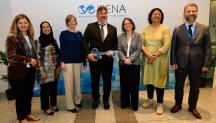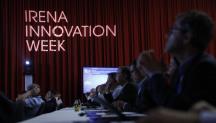

Innovation Week 2023 - Indirect electrification and workshops: As it Happens
Newsletter
IRENA Innovation Week brings together leaders, experts, industry representatives, academics and policy makers to discuss cutting-edge innovations that can support and accelerate the global energy transition. The 2023 edition is focused on the Renewable solutions to decarbonise end-use sectors.
Day 2: Indirect Electrification: Decarbonising Hard-to-abate Sectors
Events of day one focused on Direct electrification – Renewable-powered solutions. See the programme and watch the highlights below.
Walking the last mile of the energy transition with green hydrogen
The first session of the day focuses on the key innovation dimensions for green hydrogen, including enabling technologies, market design and regulation, system planning and operation, and finance and business models.
The panelists will discuss how innovation in green hydrogen can help to decarbonise hard-to-abate sectors. Check out our publications on the innovations in hydrogen, including Innovation Landscape 2023 and Innovation Trends in Elecrolysers for Hydrogen Production.
Hard to abate end-use sectors, including steel-making, chemical production, long-haul aviation and maritime shipping face an electrification challenge in terms. Yet, a viable technical solution for decarbonising these end uses is already available – “green” hydrogen and other fuels produced from renewable electricity will play a key role. IRENA’s 1.5°C Scenario projects that by 2050, clean – green and blue – hydrogen production will grow to 523 million tonnes per year by 2050. Hydrogen can also serve as an excellent energy storage medium.
In his keynote Francisco Boshell, Head Innovation and End Use Applications, IRENA, gave an overview of global hydrogen supply needs which need to grow six-fold to meet the climate goals. Although much has happened in hydrogen innovation over the last years, further developments and a smart approach to integrate electrolysers in power systems are required. The newest Innovation Toolbox guides the policy makers in formulating smart electrification strategies for their own contexts, and proposes an advanced hydrogen economy toolbox, featuring three individual toolkits. See them here.
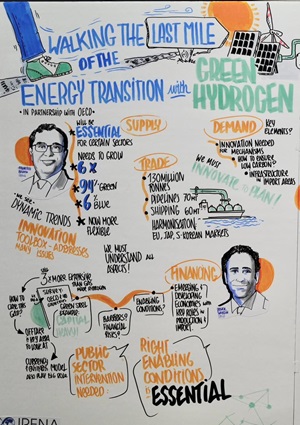 Deger Saygin, Industry Programme Lead, OECD focused on the innovation in green finance for hydrogen and how the emerging economies can play a key role in green hydrogen export market. He underlined that these countries need assistance in reaping benefits across the whole hydrogen value chain. Alicia Eastman, Intercontinental Energy offered a perspective on green hydrogen investment and how to make it viable and efficient to deliver green hydrogen and ammonia projects at scale. The key points outlined are shown on the visualisation. |
The panelists agreed that the key priorities for hydrogen in terms of technological advancements include improving efficiency of electrolysers, costs reduction, grid optimization via digitalisation and cybersecurity, and tackling the embrittlement issues. In addition, the regulation processes need to be more streamlined; structure for financing including blended finance, needs to be consolidated; and international collaboration needs to be promoted.
Solutions to decarbonise the iron and steel sector
The industrial sector is the second largest emitter after power generation. Iron and steel sector is hard to decarbonise, yet without increased emission reduction efforts within the sector, it will be challenging to reach the climate goal. Opening this session, Luis Janeiro, Team Lead – End Use Sectors, IRENA stated that “steel is an integrated part of human development. Decarbonisation of steel sector is crucial for the decarbonisation of the overall energy sector.”
This session is supported by the Alliance for Industry Decarbonization, consisting of private and public organizations and stakeholders operating in energy-intensive sectors, committed to collaborating toward the common vision of a green future, and coordinated by IRENA.
Progress in the sector is visible today, spread around the world and around the industry, the panel agreed. The discussion brought up an array of important key takaways visualised below.
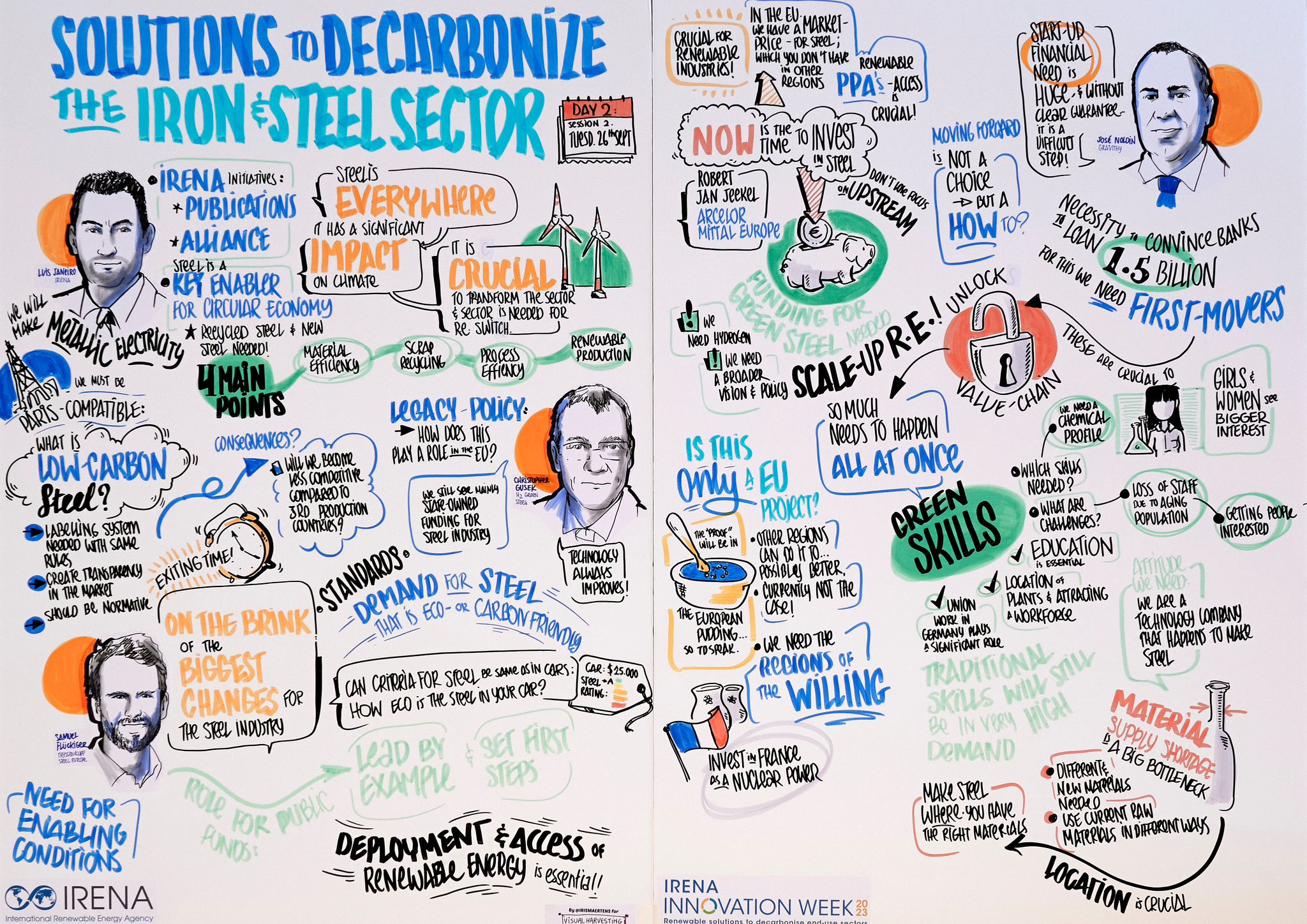
The panelists discussed a set of potential solutions for decarbonisation of the sector, underlining that the key advantage of steel is that it can be recycled. Recycling already accounts for one-third of global steel production and 50% of global steel demand by 2050 can be met via steel recycling. Yet, circular steel sector requires improved material and process efficiency; increased steel recycling; and the adoption of renewable energy sources for steel production. The IRENA report provides a comprehensive analysis of the challenges and opportunities associated with improving circularity in the sector.
The panellists underlined that the technology is not an impediment anymore – it is the clear regulations and standards that are missing. Without a clear definition of green steel, a demand cannot be generated, and funding cannot be obtained. In addition, the sector needs a vast amount of renewable energy and a “metallic electricity” is possible in the future supported by policy developments and financing.
Youth-led Innovation for a just energy transition
On the side-lines of the Innovation Week 2023, a number of youth-focused events is taking place. The participant of the NewGen initiative have an opportunity to listen to the technical and policy-focused discussions, network and exchange their experiences to date.
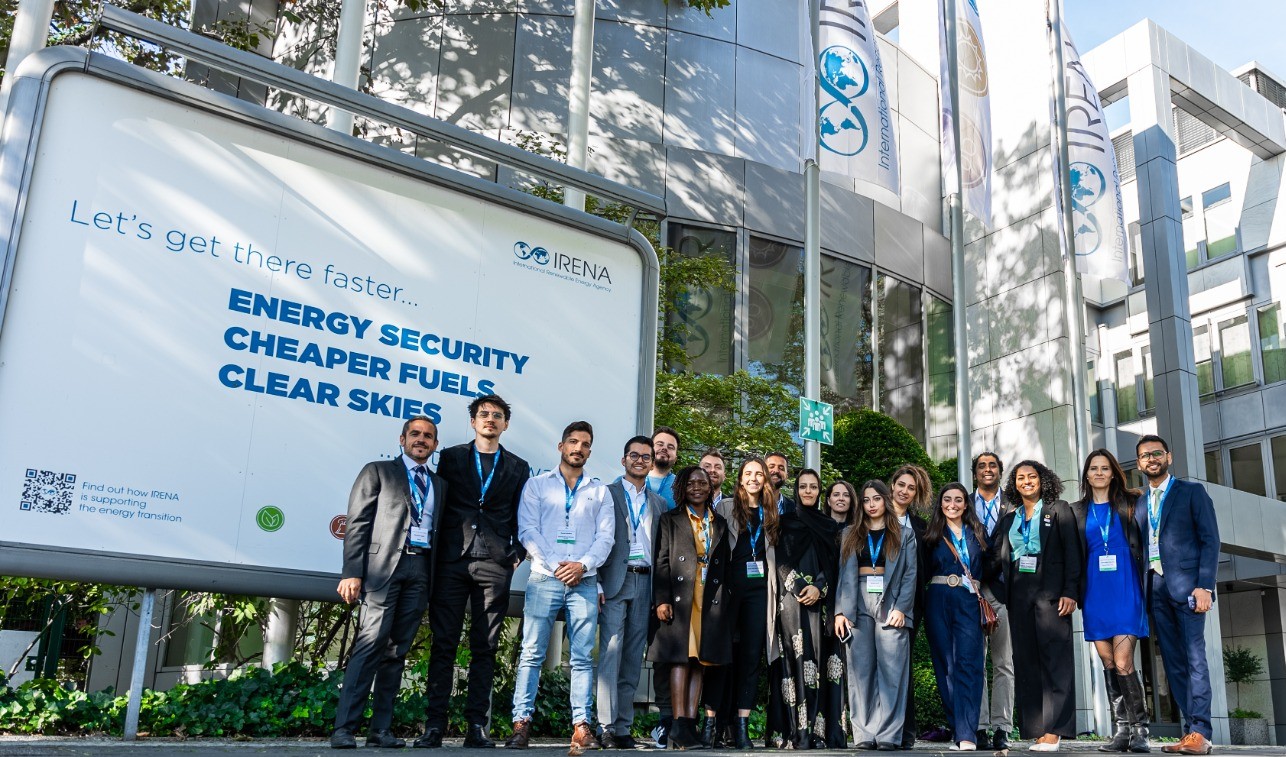
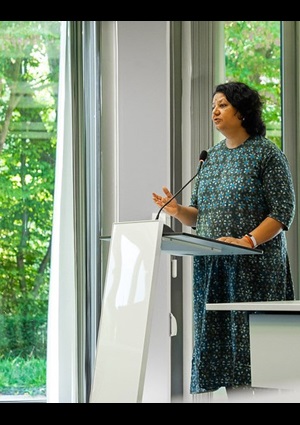 In her keynote speech, HE Dr. Nawal Al-Hosany, the Permanent Representative of the UAE to IRENA, underlined the importance of youth and their action in the energy transition. “we need creative minds and innovation to accelerate the energy transition further and to make solutions more efficient and affordable for everyone,” she said. Later this year, the UAE is hosting COP 28, one of the most important platforms to drive the climate change agenda forward. A special emphasis is given to the Youth during the event, she mentioned, inviting the participants to join the discussions in December 2023. Gauri Singh, Deputy Director-General of IRENA addressed the young entrepreneurs and underlined the importance of their contribution to the energy transition, also via innovation. "Let's leverage this opportunity to catalyze positive change and work collectively towards a future where renewable energy empowers communities, mitigates climate change, and leaves no one behind," she encouraged the Youth gathered at the session. |
It's a great joy to discuss youth-led innovation at @IRENA’s #IIW2023.
— Gauri Singh (@GauriYSingh) September 27, 2023
The role of youth in the global #energytransition cannot be emphasised enough. Young innovators & change-makers hold the key to unlock a future powered by #renewables, resilience & inclusivity. pic.twitter.com/m0An51YYEv
Solutions to decarbonise the chemical and petrochemical sector
The chemical and petrochemical sector is another industry sector that remains hard to abate. Solutions for each sector are different and in case of the chemical and petrochemical sector, the biggest obstacle is not a lack of innovative technologies but rather an inconsistent regulatory framework.
The panelists agreed that there is no silver bullet and a variety of solutions will be needed to transition. Renewables will play a key role in the process, yet the industry will need to strike a balance between maintaining the competitiveness and moving forward decisively with the transition. The support of policy makers and the finance industry is crucial to create a level playing field internationally to enable investments in the sector and drive the transition.
Solutions to decarbonise the shipping and aviation sectors
Decarbonisation of the shipping and aviation sectors remains a challenge on the path to 1.5°C. In this session, the panelists will discuss potential innovative solutions for these hard to abate sectors.
Kicking of the discussion with a keynote, Pierpaolo Cazzola, Director of the European Transport and Energy Research Center, ITS UC Davis outlined areas that need attention in the shipping and aviation sector. He mentioned that the technical solutions offer efficiency and operational improvements but readiness, scale-up and cost are the key considerations. For example, electrification is a viable solution for short haul aviation only, while renewable e-fuels such as e-ammonia and e-ethanol are competitive candidates for maritime fuels although their adoption remains uncertain. Finally, policy support for innovation and tech development is crucial.
Renewables play a key role in the decarbonisation of the industry. Carlos Ruiz, Programme Officer – Innovation and End-use Sectors, IRENA, stated that not all solutions are suitable for the shipping and aviation sectors and a smart approach to prioritization of available options, planning, timely development of the infrastructure and regulations are vital.
International shipping is a key sector of the economy with as much as 90% of worldwide trade transacted via ocean going vessels. IRENA report, Pathway to Decarbonise the Shipping Sector by 2050 explores the options and actions needed to progress towards a decarbonised maritime shipping sector by 2050 identifying a realistic pathway to reach the 1.5°C climate goal.
The summary of the key points from this session is provided in the visualisation below.

Future materials for EV batteries
IRENA research shows that the number of electric passenger cars would grow to 360 million by 2023, and 2 180 million by 2050 under IRENA's 1.5°C Scenario. The demand for EVs will drive the need for materials such as lithium, graphite and cobalt. It is therefore imperative to develop sustainable and equitable supply chains for critical materials.
The panellists outlined key innovations that promote the development of sustainable supply chains. These, among others, include adapting battery manufacturing processes that are less reliant on the associated battery chemistries; developing circular economy initiatives that allow for all EV battery stakeholders to recycle of critical materials effectively; enhancing R&D capabilities to allow for new technologies to be integrated into the market; and developing standardization protocols for the manufacturing process.
Read the article on why EV-battery innovation is key to sparking a renewable revolution.
Grid Evolution: Transforming Energy Landscapes in Developing Countries and SIDS
This session focused on innovations in technology, financial mechanisms, technical standards, best practices, and strategic approaches to modernize electricity grids and increase their reliability while integrating variable renewables in developing countries and SIDS systems.
In his keynote, Simon Benmarraze, Team lead, Technology and Infrastructure, IRENA, set the scene statiung that the solution lies in developing a climate adaptation strategy, both in transmission and distribution systems, and developing resilient enhancement measures for short- and long-term solutions.
“A critical point for a successful transition is stakeholder collaboration from all actors including utilities, regulators, private sector, as well as financial institutions,” said H.E Mr Kaleb Udui, Jr., Minister of Finance, Palau. Only balance energy efficiency and renewable energy deployment we can reach 100% renewable target, he continued.
The key points raised centred around the grid modernization helps support end-use electrification and improve power system resilience. Smooth collaboration between utilities, regulators, and other stakeholders is required to ensure that grid modernization and end-use electrification are effectively integrated. Small Island Developing States (SIDS) are particularly vulnerable to the effects of climate change and there has been a growing focus on improving the efficiency and reliability of power grids, as well as integrating renewable energy power into the grid. Modernizing the grid can allow for better management of distributed energy resources, including rooftop solar panels and EVs.
Geopolitics of the energy transition: Innovation in critical materials
This session brings together policy makers, experts and industry leaders to discuss potential impact of innovation on the availability of demand for critical materials. The energy transition will be mineral- and metal-intensive, driving demand for selected critical materials. Innovations in technology can influence demand by introducing substitutes, enhancing efficiency, optimising designs and incorporating new materials. Elizabeth Press, Director, Planning and Programme Support, IRENA kicked off the discussion stating that the "disruptive innovation will have a lot of impact on how the the demand for materials will evolve in the coming years."
The recent IRENA report on the Geopolitics of Energy Transformation: Critical Materials offers a comprehensive insights into the significance of critical materials, examining their associated geopolitical implications and offering recommendations for a sustainable and efficient global energy transition.
The discussion revolved around a few key points, including supply and sustainability of critical materials for the energy transition; innovation across the value chain, including recycling, resource efficiency, and material reduction; and inclusive collaboration. First, focus on diversification and mitigating risks, responsible sourcing, environmental sustainability, and transparency in material extraction and processing is crucial. Moreover, effective policies, multi-stakeholder partnerships, governance frameworks, and global standards are needed to address gaps, support sustainable development, navigate the complexities of the critical materials landscape, and promote transparency throughout the supply chain. Countries will require supporting to move up the value chain to create local value and foster development.
Finally, the discussion also challenged several myths around critical materials, such as concerns about lithium supply scarcity, the potential for cooperation in the renewable energy sector, and the misconception that increased material demand will lead to resource depletion without considering sustainability and recycling efforts.
The summary of the key takeaways is provided on the visualisation below.
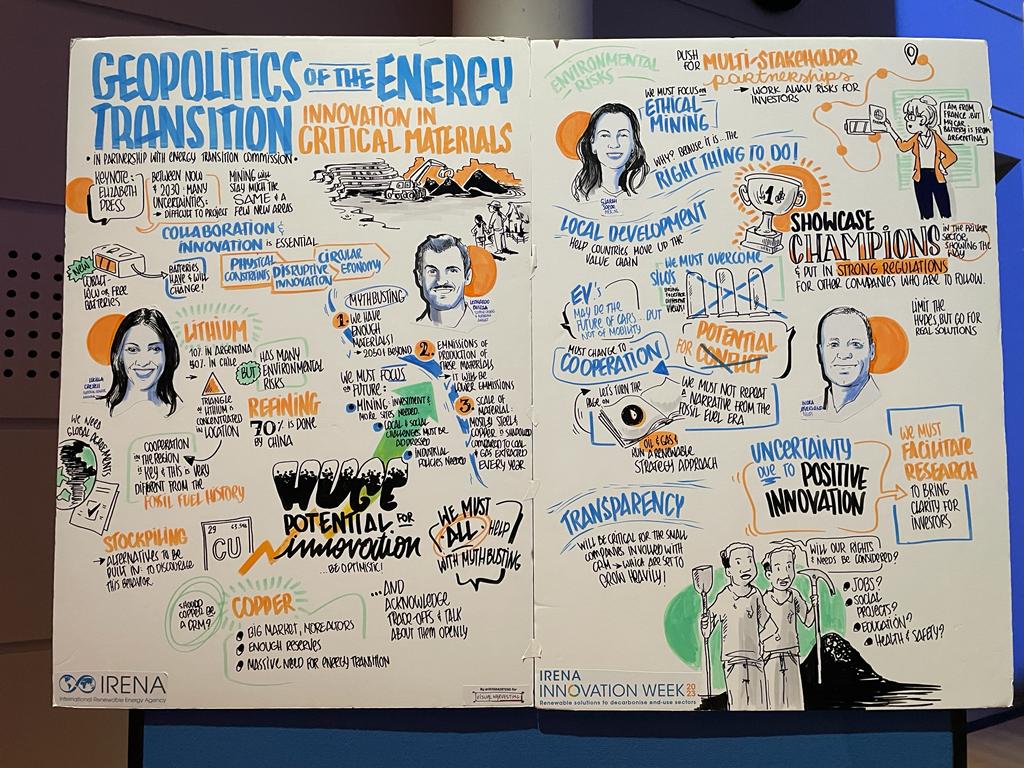
Day 3: Innovation sessions and workshops
Demand side management and storage
This session discusses the importance of demand-side management in the energy transition, sharing strategies from different regions and showcasing private sector innovations in incentivizing and implementing demand-side solutions.
The integration of variable renewable energy sources requires unlocking demand-side flexibility, driving the shift from centralized to decentralized energy systems and transforming consumers into prosumers.
Demand side flexibility capacities need to increase across all regions, and the process requires policy support. Correct policies would help reducing peak load,upgrading energy efficiency and facilitate variable renewable energy integration. IN addition, responsiveness, duration, frequency, reliability, and cost should be considered when incorporating demand flexibility options.
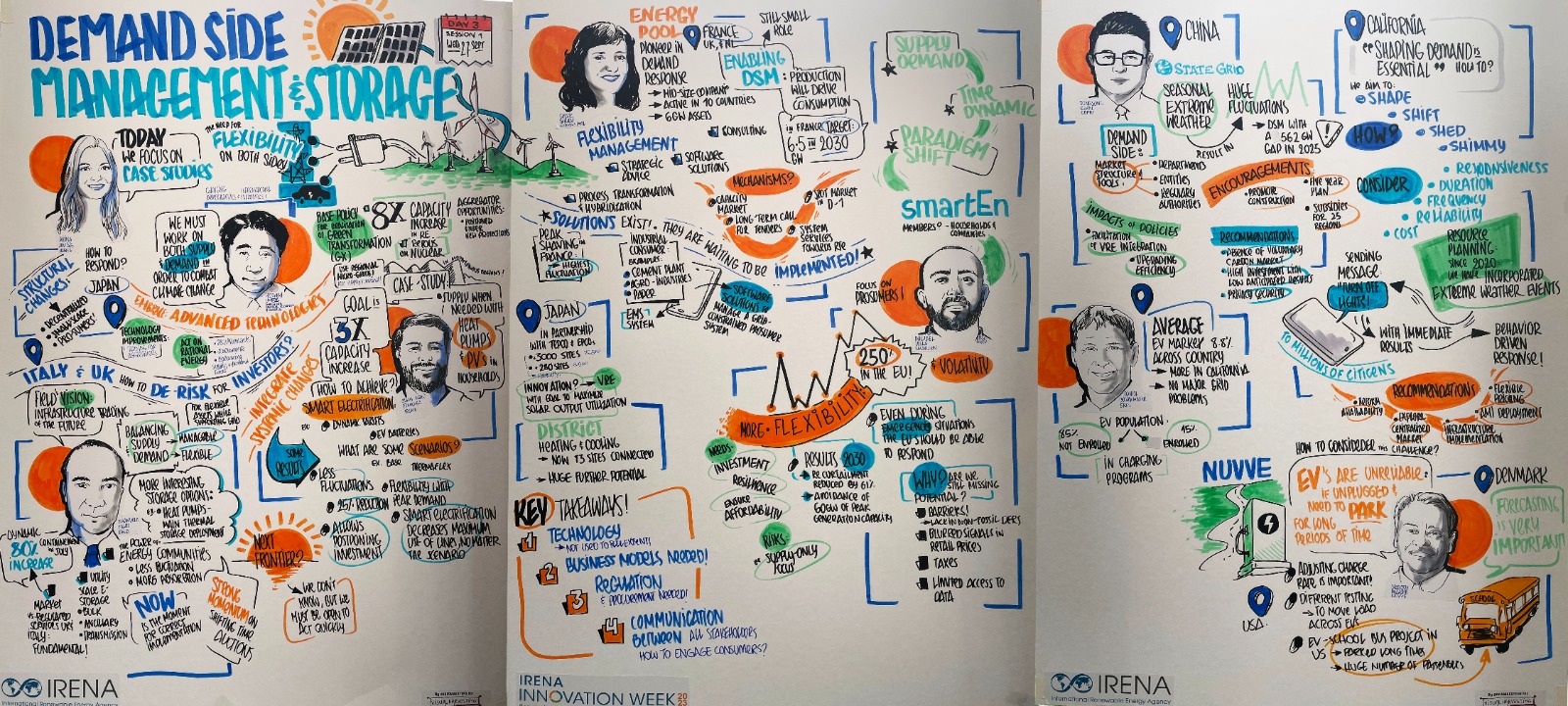
Enabling data driven decision making – The Energy Innovation Metrics Hub (Mission Innovation)
This session provides an overview of the the Mission Innovation Energy Innovation Metrics Hub. The Hub’s aim is to establish an online database and dashboard visualising innovation data and metrics.
Measurable quantitative indicators are required to assess, drive and accelerate the energy transition. Trends in patent data, for example, can be an indicator for innovation, commercialization and market progress in different sectors, and in turn help create robust policies to facilitate further implementation of innovative solutions.
After informative presentations from the experts on tracking innovation progress, the participants discuss challenges around data gathering, such as issues with timing, quality and availability of data, or need for robust processing.
